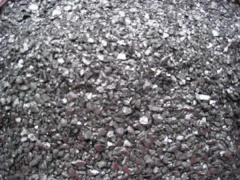Graphite
| Infobox on Graphite | |
|---|---|
| Example of Graphite |  |
| Facts | |
| Origin | - |
| Stowage factor (in m3/t) |
|
| Humidity / moisture | - |
| Ventilation | - |
| Risk factors | See text |
Graphite
Description
The mineral graphite is an allotrope of carbon. Unlike diamond (another carbon allotrope), graphite is an electrical conductor, a semimetal. It is, consequently, useful in such applications as arc lamp electrodes. Graphite is the most stable form of carbon under standard conditions. Therefore, it is used in thermochemistry as the standard state for defining the heat of formation of carbon compounds. Graphite may be considered the highest grade of coal, just above anthracite and alternatively called meta-anthracite, although it is not normally used as fuel because it is difficult to ignite.
There are three principal types of natural graphite, each occurring in different types of ore deposit:
1) Crystalline flake graphite (or flake graphite for short) occurs as isolated, flat, plate-like particles with hexagonal edges if unbroken and when broken the edges can be irregular or angular;
2) Amorphous graphite occurs as fine particles and is the result of thermal metamorphism of coal, the last stage of coalification, and is sometimes called meta-anthracite. Very fine flake graphite is sometimes called amorphous in the trade;
3) Lump graphite (also called vein graphite) occurs in fissure veins or fractures and appears as massive platy intergrowths of fibrous or acicular crystalline aggregates, and is probably hydrothermal in origin.
Highly ordered pyrolytic graphite or highly oriented pyrolytic graphite (HOPG) refers to graphite with an angular spread between the graphite sheets of less than 1°.
Application
Use; crucibles, retorts, foundry facings, moulds, lubricants, paints and coatings, boiler compounds, powder glazing, electrotyping, monochromator in x-ray diffraction analysis, fluorinated graphite polymers with fluorine to carbon ratios of 0,1-1,25%, electrodes, brocks, chemical equipment, motor and generator brushes, seal rings, rocket nozzles, moderator in nuclear reactors, cathodes in electrolytic cells, pencils, fibers, self-lubricating bearings, intercalation compounds.
Shipment / Storage
May be subject to loss in weight due to seepage from containers, with subsequent siftage. If shipped damp consequent loss of weight will increase on drying out.
Packaging is all important with this cargo, due to the mess it can make if the powder should leak.
Graphite shipped in kegs or cases should have an interior lining of stout paper or plastic. If shipped in bags they should be double with a plastic inner.
All precautions should be taken to protect other cargo in the vicinity or graphite from powder or dust damage. Experience gained in shipments from China has shown that graphite residue deposited on container sides and floors requires special cleaning and steam cleaning by itself is insufficient. Important to avoid dampness affecting this powder.
Graphite has been known to taint other sensitive cargoes.
The container selected for this cargo should be a 20 ft GP and one of the older one’s in the fleet. The container shall be lined with plastic foil using tape to affix to the container walls. Great care must be exercised in loading to avoid a leaker and packaging which is suspect should be drawn to the attention of our appropriate sales representative.
If forklifts are used in loading then old plywood or similar should be temporarily laid on top of the plastic tearing and exposing the container floor.
Risk factors
Hazard; (powder, natural) fire risk. TLV: 2,5 mg/m3, respirable dust.
Consult the applicable MSDS sheet.











